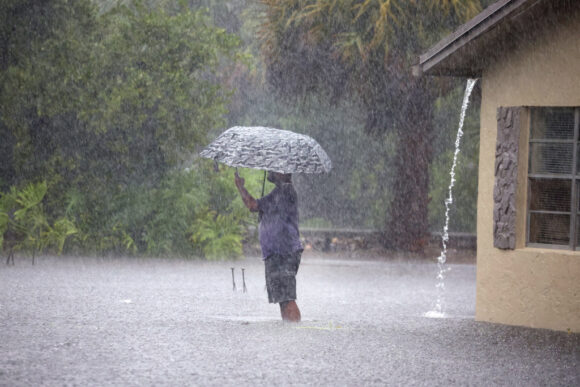Despite the dangers and expense associated with living in high-risk areas, large numbers of people are still moving to parts of America most impacted by wildfires, flooding and extreme heat.
According to a new report from real estate company Redfin, high-risk counties in states such as Texas and Florida are seeing an influx of residents, even as dangers such as fire and flooding become more frequent and intense.
In 2023, 63,365 more people moved into America’s high-fire-risk counties than out. Much of that net inflow was from people moving to Texas. The nation’s high-flood-risk counties saw 16,144 more people move in than out, largely due to people moving to Florida.
“Ballooning insurance costs and intensifying natural disasters are driving thousands of Americans out of risky areas, but those people are quickly being replaced by other people for whom climate change isn’t the top concern,” said Redfin Senior Economist Elijah de la Campa.
Redfin defines a high-risk county as one that ranks in the top 10% regarding the share of homes facing high fire or flood risk.
“For a lot of Americans, things like cost of living and proximity to family take precedence over catastrophe risk, which can feel less immediate and more abstract,” de la Campa added. “But the cost-benefit calculus seems to be shifting in places like California and Florida, where skyrocketing home insurance costs and an uptick in high-profile disasters have had a tangible impact on residents and made national news.”
Moving In
Migration to fire-prone Texas fueled over a third of the national net inflow to high-fire-risk areas last year. The state is home to five of the 10 high-fire-risk counties with the largest net inflows of people. A total of 97,535 people moved into high-fire-risk U.S. counties, and 35,175 (36.1%) were people who moved to Texas, up from 28.7% in 2022. All in all, high-fire-risk counties in Texas saw a net inflow of 30,156.
Texas had more wildfires last year (7,102) than any state but California (7,364) and did have the highest number of wildfires in 2022.
Migration to flood-prone Florida fueled a sizable chunk of the national net inflow to high-flood-risk areas last year. While 219,799 people moved into high-flood-risk U.S. counties, over half—117,574 (53.7%)—were people who moved to Florida. All in all, high-flood-risk counties in Florida saw a net inflow of 68,564—contributing significantly to the national net inflow. (The national net inflow is smaller than the Florida net inflow because the Florida net inflow was partly offset by outflows in other areas.) That number is down from 57.3% in 2022. This could be because people are becoming more aware of flood risk and surging insurance costs. Florida is home to six of the 10 high-flood-risk counties that saw the largest net inflows of people last year. All six are located on the Florida coast.
Conversely, America’s low-fire-risk counties saw a net outflow of 38,401 people in 2023, and low-flood-risk counties experienced a net outflow of 6,892.
Moving Out
California is seeing statewide impacts. The state has five of the 10 high-fire-risk counties with the largest net outflows in 2023. A total of 34,170 people left high-fire-risk U.S. counties last year, with 17,357 of those people—or 50.8%—leaving California, up from 41.9% in 2022. California’s high-fire-risk areas saw a net outflow of 6,937 people in 2023. That marks a reversal from 2022 when high-fire-risk counties saw a slight net inflow (+763).
In Texas and Florida, big cities are bucking the states’ migratory trends. While some migration out of city centers can be attributed to factors such as increasing housing costs or a move toward remote work, there are also climate migrants—people leaving due to climate risk.
While five high-flood-risk counties around Houston had net inflows of more than 2,000 people in 2023, Harris County, a high-flood-risk area that includes Houston proper, saw a net outflow of 22,792 people last year. Nearly one-third (31.4%) of homes in Harris County face high flood risk and 100% face high heat risk.
In Miami and Miami-Dade County, where 38.9% of homes face high flood risk, there was a net outflow of 47,597 people in 2023, a bigger outflow than almost any other county in the nation.
Roughly 1 in 11 (8.8%) people who plan to move soon cited concern for natural disasters or climate risks, according to a Redfin-commissioned survey of approximately 3,000 U.S. homeowners and renters conducted by Qualtrics in February 2024. However, other responses were much more common, such as wanting more space (32.4%), lower cost of living (26.4%), or being closer to family (16.4%).
Home Insurance Costs
“Prospective homebuyers are asking me a lot more questions about natural disasters and insurance costs than they were previously. About three-quarters of the sellers I speak to express frustration over recent increases in their insurance premiums,” said Rafael Corrales, a Redfin Premier agent in Miami.
Many homeowners in Florida and California have seen premiums climb dramatically, and some have lost coverage because insurers have stopped doing business in the two states.
Allstate, California’s sixth largest insurer, seeks to raise homeowners insurance costs by 34% on average, said Redfin. That would impact over 350,000 people and exceed the 30% hike sought last month by State Farm, the biggest insurer in the state. Allstate stopped writing new homeowners policies in California in 2022.
“If you’re looking to buy a home in Florida, you should know that you can’t be close to the water without being in a flood zone,” Corrales said. “If you’re within three miles of the coastline, mother nature is going to pay you a visit. That’s the price you pay for living in paradise.”
Photo: A man stops to take pictures of his flooded neighborhood in Dania Beach, Fla., on April 12, 2023. (Carline Jean/South Florida Sun-Sentinel via AP)
Topics Catastrophe
Was this article valuable?
Here are more articles you may enjoy.



 Viewpoint: Generative AI in Insurance Isn’t Working
Viewpoint: Generative AI in Insurance Isn’t Working  With American Mobile Out, Florida’s Mobile Home Insurance Market Seems to Have ‘Fallen Apart’
With American Mobile Out, Florida’s Mobile Home Insurance Market Seems to Have ‘Fallen Apart’  Georgia Woman Charged with Insurance Fraud After Claimed Injuries
Georgia Woman Charged with Insurance Fraud After Claimed Injuries  Guy Carpenter: ‘Kitty Cat’ CrowdStrike Outage to Cause $300M-$1B in Insured Losses
Guy Carpenter: ‘Kitty Cat’ CrowdStrike Outage to Cause $300M-$1B in Insured Losses 

